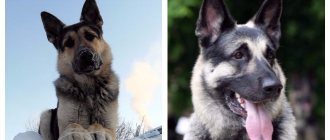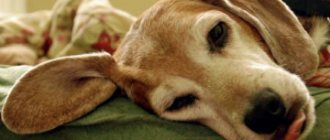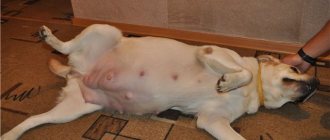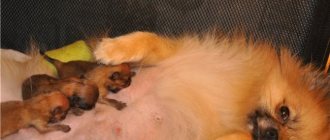The birth of babies is a special moment in the life of every owner and his pet. Often, first-time owners begin to panic during their dog's labor, finding themselves unable to help when needed. To overcome your fear and deliver a dog at home, you just need to know a few simple things. The main thing is not to worry and be well prepared.
How to understand that childbirth is near
As the cherished day approaches, the bitches' behavior changes. They become more excited, fussy, looking for a place where the process will take place. Over the course of one and a half to two weeks, the stomach begins to gradually change. This happens because the fetuses are approaching the birth canal. Visually, it seems as if the stomach has shrunk a little - this is a natural process, there is no need to worry.
At the same time, the expectant mother begins to lie down more and more, since it is already difficult for her to walk. It's time to find a place where the process will take place and learn how to deliver a dog.
When there are only a few days left before whelping, mucous discharge from the vagina appears. This is how the cork comes out, which prevented the fruits from being born ahead of schedule. Most often, the plug comes off unnoticed.
Sometimes discharge also appears from the nipples - especially if the bitch is pregnant not for the first time. This stage can be easily determined by the characteristic behavior of the animal. She licks herself often and spends quite a lot of time doing this, and stains remain on her bedding or diaper.
Signs of the onset of labor in a dog and the process itself are difficult to miss. A few hours before giving birth, the pet’s water breaks, which contained the fetuses. This means that she will give birth very soon, which means it’s time for the owner to prepare.
Childbirth in dogs: signs, precursors, beginning, how to deliver a child in small and large breeds of dogs
Childbirth in dogs is a long-awaited time for many owners. We will now talk about what to do during this period, what are the harbingers of childbirth, what is the beginning, how to give birth to your pet, be it a large or small breed.
Let's start with the fact that dogs, like all animals, have a genetic memory of how to behave during childbirth. However, living next to a person, her behavior sometimes obeys her owner. And sometimes she can get lost during childbirth and even ask a person for help. In addition, do not forget that dogs, like all mammals, may have some deviations in anatomy and physiology, which can affect the course of labor and the health of the dog and its offspring in the future.
Should I contact a veterinarian?
The first question that worries many young dog lovers, especially if their dog is giving birth for the first time, is whether to call a veterinarian or not?
Experts recommend the following: if you are worried yourself, if you have never seen it and do not know what to do during this period, then it is better to call a doctor from any veterinary clinic.
If you have had experience caring for a pregnant dog, have given birth to her, and if something happens you don’t get confused or faint, then you can safely give birth yourself, and only in case of complications (which we will talk about below) call a veterinarian. You just need to warn him about this in advance by calling him at least a few hours before the birth itself.
Precursors, onset and signs of labor in dogs
So, the harbingers of childbirth in dogs are the following:
- a change in the dog’s behavior - it becomes somewhat restless, begins to walk around the rooms, look for a place where it is comfortable to lie down, after a couple of minutes it gets up and looks for a new place, it may follow you and ask for something, - periods of rapid breathing, - water breaking ( many may mistake this for urination), - pushing (emphasis on the letter “o”) is tensing the muscles of the abdomen and uterus, at this moment the dog can hold its breath for a second.
Signs of the onset of labor in dogs is the moment contractions begin. Contractions are contractile movements of the uterus that help push the fetus out. Contractions usually occur at short intervals. At first they are repeated every 10-15 minutes, then their interval is shortened, and by the time the fetus is born, contractions occur every 2-3 minutes.
After the puppy is born, it should squeak, which will indicate that the lungs are filled with air and that the puppy is alive. The dog must gnaw the umbilical cord connecting the puppy to the afterbirth, which is still in the dog's uterine cavity. Then she should lick it, removing traces of the membranes and clearing the mucus from her nose. Then after 10-25 minutes the afterbirth should come out with small streaks of blood, the dog should eat it. Once the dog has done all this, the puppy can be placed slightly to the side on a pre-prepared bedding so that the dog does not crush it during the birth of the next puppy.
Attention
What should the owner pay attention to?
1) If 2 hours have passed after the onset of labor and the puppy has not been born, be sure to call the veterinarian. 2) If at the time of birth, scarlet blood flows from the dog’s genital tract (not the streaks of blood that accompany the separation of the placenta, but scarlet blood in a good stream), then urgently call the veterinarian or take the dog to the nearest veterinary clinic. 3) If the afterbirth still does not come out even after 2-3 hours (be sure to keep an eye on this!!!), then call the veterinarian urgently. 4) If the dog has not chewed the umbilical cord, tie it with thread at a distance of 3 cm from the puppy’s tummy, and then cut it with scissors treated with alcohol or hydrogen peroxide. 5) Usually 20-30 minutes pass between the birth of puppies, but it can be up to 1.5 hours. If the second puppy is born after 8-10 hours, be sure to call your veterinarian. 6) After all the puppies are born, be sure to change the bedding under them to dry, lay the dog down and place all the puppies on her nipples, let them suck milk and gain strength.
Video on childbirth in dogs
1) First video – childbirth in a large breed dog
2) Second video - childbirth in small breed dogs - toy terrier
- York
Preparing for childbirth
Experienced breeders have completely different views on where and how a dog gives birth: some are sure that a pet should whelp exclusively on a bed, sofa, or at least on soft bedding. Others immediately put it in a spacious box in which the mother and her children will spend the near future.
What you will need
Be sure to prepare a first aid kit for the mother in labor or babies. It should contain the following:
- iodine and brilliant green;
- antiseptics (medicinal alcohol or peroxide) - they will come in handy when you need to treat instruments or hands;
- in case the bitch does not gnaw the umbilical cord herself, it is better to get special scissors;
- clamp;
- syringes;
- cotton wool, bandages, gauze and other dressing materials;
- suction in case puppies are born in a bubble and cannot breathe normally;
- Oxytocin injections are helpful if your dog is not having contractions.
Clean cloths and disposable diapers never hurt. It is worth stocking up on water so that the bitch can quench her thirst during childbirth.
It would be ideal if one of the family members takes a short vacation during the whelping period and takes care of the mother and her babies. This can be called a necessity if the dog is giving birth for the first time.
Where to place the dog
Of course, a bitch will give birth in any conditions, but decent owners still take time to arrange a comfortable and convenient nest. The bed is not the best place for dogs and puppies, as the animal will not find it very secluded. Rapidly grown puppies will begin to crawl and fall, which will lead to serious injuries to fragile babies. In addition, discharge during childbirth can stain everything, including the mattress - so this option is not the most hygienic.
Almost all owners prefer to place their pet in a box covered with soft material. The puppies will not have the opportunity to get out, which means they will remain under the strict supervision of their mother. Another plus is that during the birth process the dog has the opportunity to rest its hind legs on one of the sides, and this will greatly facilitate contractions.
There are several rules that need to be followed when arranging a family house for a dog.
- Choose a box based on the size of your dog. A box that is too tight is just as bad as one that is too spacious. The bitch should fit in it herself, and also leave room for the puppies.
- The sides of the box must be no lower than the height of the animal in a lying position.
- Cover the bottom with a light cloth. Thanks to this, you can control discharge before, during and after childbirth. Do not forget to promptly change the soiled diaper to a dry one.
- It is best to place a mattress or a sheet of thick foam rubber under the diaper. This will allow the mother to sit comfortably inside and reduce her discomfort.
- Prepare a second, smaller box. Puppies must be placed there before giving them to their mother. Place something warm inside the box - a heating pad wrapped in cloth.
Be sure to let your dog get to know your box beforehand. Let her get used to it. If this is not done, the animal will find its own secluded place, to which a person will most likely have difficulty accessing. And the presence of the owner is mandatory during dog births at all times.
Place the box in a visible place and put some treats in it. If your pet does not get into it for a long time, pay attention to whether you have chosen the right size and bedding.
Preparing for the birth of a dog at home
A dog's pregnancy lasts approximately 63 days (range 57 to 68 days) , depending on the breed and size of the female. The period is calculated from the day of the first insemination. Approximately two weeks before giving birth, the animal experiences changes in behavior as the dog begins to prepare for the birth of puppies.
The owner should also prepare in about the same two weeks. Ideally, pregnancy and childbirth take place under the supervision of a veterinarian, but if it is impossible to contact a specialist, the dog owner must take care of his pet himself.
First of all, you need to take care of your future offspring. It is necessary to build (or buy) a special pen in which the mother will be with the puppies:
- The design of the playpen is simple and consists mainly of 4 sides, which will prevent growing puppies from spreading out.
- The height of the sides depends on the size of the dog - they should be high enough so that the puppy cannot crawl over it, but the female can get out freely and without difficulty.
- On the inside of the sides it is necessary to nail solid shelves along the entire perimeter of the pen - its height also depends on the size of the dog. This shelf is needed so that the mother does not crush the puppy when she lies down (this is especially true for large dogs) - the puppy can crawl to the side and the mother may not notice him and crush him with her body.
Immediately before giving birth, you need to cover the playpen with a warm cover and clean diapers, and also prepare a few more items:
- Clean towels – dry the puppies. The more puppies, the more dry towels there should be.
- Scales and a notebook where the weight of the puppies at birth will be recorded, so that later you can monitor the weight gain of the babies.
- Clean water should always be available when the dog wants to drink, it should not get up and the bowl of water should be close.
- Sterile gloves in case you have to help your dog give birth.
- Oxytocin to stimulate contractions (but strictly as prescribed by a doctor and under supervision). Stimulation can lead to very sad consequences if it is carried out at the wrong time or injected in excessive quantities.
We measure the animal's temperature before giving birth
The normal body temperature of a dog depends on the size of the dog and ranges from 37.5 to 39 degrees . The larger the dog, the lower its body temperature. For a German shepherd, 37.8 - 38.0 is a normal temperature; for miniature dogs, 39 is also normal.
The main, but not the only, sign of the onset of labor is a decrease in body temperature by about 1 degree. The temperature drops approximately 12-24 hours before the first contractions appear.
Body temperature must be measured rectally . To do this, the dog is laid on its side. The tail is moved back, the tip of the thermometer is lubricated with oil or Vaseline and inserted into the anus approximately 1-1.5 cm . If the thermometer is electronic, then you need to remove the thermometer after the sound signal; a simple mercury thermometer is removed after 1.5-2 minutes .
You can also measure body temperature in a standing position if the dog does not resist: the animal is fixed in one position, the tail is moved back, then the same manipulations are performed.
If the birth is premature
Premature birth always indicates some pathology in the development of the fetus or a disease in the dog. Therefore, if labor begins prematurely, you need to immediately bring the dog to the veterinarian or call him at home: the risk of losing not only the puppies, but also the mother dog is very high.
When labor begins, you first need to calm the dog down by stroking its sides . If you absolutely need to save the puppies, you cannot do without veterinary care and a caesarean section - because... The dog's body is not prepared for childbirth, contractions may begin later or be too weak, and the puppies may die from suffocation.
Under no circumstances should labor be interrupted! This threatens the death of not only the puppies, but also the dog.
Childbirth process
As a rule, dogs cope on their own without human help. Regardless of breed or size, the scenario is always the same. However, the owner must be present during the birth to reassure and comfort the animal, as well as to prevent complications in time and call the veterinarian.
How long does labor take?
It all depends on the stages of childbirth in dogs. It happens that each stage goes quickly, and the whole process takes up to 6 hours. Sometimes labor drags on for almost a day, and this is also considered normal. Anomalies are usually recognized not by the total duration of labor, but by too long a time interval between stages.
It’s difficult to say how long a dog’s labor lasts – this indicator is purely individual. It depends on the number of fruits, the condition of the bitch and her age. The whole process takes from three to twenty hours, but in most cases everything ends after 7-9 hours.
If there are a lot of puppies in the stomach, this does not mean at all that the process will be drawn out. Rather, on the contrary: the fewer cubs, the longer the process. In addition, the duration of pregnancy depends on the number of puppies.
The most difficult thing will be the birth of your first puppy. The rest of the babies will be born faster. The interval between puppies can last up to half an hour, but the fewer puppies, the shorter the interval.
What should cause concern is the large time gap between the appearance of puppies - normally it is a maximum of an hour. If the next baby does not appear for 2-3 hours, you need to call a veterinarian.
If labor is delayed, it is worth inviting a veterinarian to your home, because the puppies inside the uterus can simply suffocate. Also, the cause of protracted labor can be simple fatigue of the mother. To prevent this from happening, veterinarians recommend giving the animal strong tea with sugar. It stimulates the cardiovascular system and gives strength.
Description of the process by stages
Contractions begin first. At first they are invisible and very weak, but over time they become more frequent and intensify. The contraction period lasts on average 6-12 hours, it is not difficult to determine: the bitch breathes frequently, can whine and rush about.
Then the first attempts occur. The bitch takes a comfortable position for childbirth. At this time, the fetus is already approaching the birth canal. At this moment it is better not to interfere: the expectant mother herself will take the position and begin to push the puppy out.
Then a dark purple bubble appears. At this point, inexperienced owners begin to get scared and sound the alarm. In fact, there is nothing to be afraid of here: it is from such a bubble that puppies emerge. During the entire process, it becomes larger and smaller until the bitch pushes it out completely.
Now the puppy himself appears. It is born in a shell, which the mother bites through so that air can flow to the baby, after which it gnaws the umbilical cord. If this is the first pregnancy, then the new mother sometimes does not pay attention to the baby - in this case, you need to take matters into your own hands and first get rid of the bubble, and then cut the umbilical cord.
Make sure that after each puppy, its placenta comes out. Sometimes she comes out after the next baby. When it's all over, count the number of puppies and afterbirths. If something does not match, be sure to show your pet to the doctor - she will need to remove the undelivered placenta so that sepsis does not start.
After the baby is born, the mother will begin to care for it: licking it to remove mucus and massaging it with her tongue to improve blood circulation. After that, he will find the nipple and drink milk. If the puppy has any problems, point him in the right direction or place him near the nipple.
Features of childbirth in different breeds and sizes
Some breeds of dogs require mandatory human assistance during childbirth, up to a cesarean section - these are brachycephalic dogs (pugs, bulldogs, Japanese chins, Pekingese, etc.), which begin to choke during strong contractions and attempts. Successful births in these dogs at home are extremely rare - it is better to consult a veterinarian.
The second risk group by breed is mastiffs. This is explained by the weak heart of giant animals and the frequent occurrence of multiple births. Childbirth can drag on for a long time, since the uterus in the middle of the process simply loses its tone and refuses to push out the puppies. Childbirth in mastiffs of all categories must take place strictly under the supervision of a veterinarian.
In general, births in large dogs can be complicated by multiple births. If the ultrasound showed ten or more puppies, it is better not to risk it and ask the veterinarian to be present at the birth.
The third risk group is dwarf breeds, especially toy terriers and Yorkshire terriers. The fact is that the fetuses are too large for such dogs, and they often experience obstruction of the birth canal.
In addition, dogs of miniature breeds have a weak maternal instinct. If an experienced dwarf breed bitch takes good care of the babies, a primiparous dog is unlikely to understand what needs to be done. Here the owner will have to make an effort to care for the puppies for the first few days.
Childbirth is easiest for large dogs and medium-sized dogs. Both yard and purebred females up to 50 cm in height produce up to 6-8 puppies and easily survive the entire birth process.
dog
DOG , and, f.
1. Family pet canids. Service dogs. Indoor dogs. Dvorovaya village Okhotnichya village Storozhevaya village You won't find anyone with dogs. (difficult to find someone; colloquial). A dog's death for a dog (a message about someone who, having lived an unworthy life, did not deserve a worthy end; simple). S. in the manger (about someone who, having something, does not use it himself and does not allow others to use it; colloquial disapproved). Like a dog needs a fifth leg. (need something) (completely unnecessary, not necessary; simple. disapproved). The dog barks, the wind blows (last: let them talk, scold, don’t pay attention).
2. trans. About an evil, rude person (colloquial).
3. for what, in what and with undef. An expert, dexterous in something. actually a person (simple). He dances with us. He sings well, sir, you'll listen to him.
4. In certain combinations: the name of predatory mammals of the family. canids. Raccoon village Wild village dingo.
• That's where the dog is buried! That’s the crux of the matter, that’s the reason.
Like uncut dogs (colloquial disapproval) there are a lot of people.
To hang all the dogs on someone (colloquial disapproved) to base accusations on someone unreasonably.
Like a dog is tired (hungry, cold, angry and about other unpleasant states, situations) (simple) very much. I'm chilled, I want to eat like a dog. I'm tired of you like a dog.
Not a single dog (simple disapproved) no one.
Each or any dog (simple disapproval) about people: any, everyone.
I ate the dog on what and in what (colloquial) acquired great skill in something, knowledge.
The priest had a dog (colloquial, joking and disapproving) about the endless repetition of the same words and actions (the original beginning of a comic saying built on the repetition of the same thing).
| decrease dog , and (to 1 value).
| unich. little dog , and (to 1 value).
| adj. dog , ya, ye (to 1, 2 and 4 meanings). Sled dog racing. Dog devotion, affection, obedience (also transl.). S. scent (also translated: about a heightened sense of smell).
Source: Explanatory Dictionary of Ozhegov and Shvedova on Gufo.me
Meanings in other dictionaries
- dog - About the appearance, physical condition, thoroughbred of the dog. Outbred, tailless, hairless, mad, sick, fast, fleet-footed, pot-bellied, fold-eared, hardy, smooth, smooth-haired, hairless, two-stranded, long-muzzled, long-legged... Dictionary of Russian language epithets
- dog - • Strong-toothed (Sergeev-Tsensky). Dictionary of literary epithets
- dog - DOG, dogs, female. 1. plural only Genus of predatory mammals (zool.). Dogs include the wolf, jackal, fox, etc. 2. A four-legged tamed or domestic animal that makes characteristic sounds (barking) and serves a person in domestic life, especially. Ushakov's Explanatory Dictionary
- dog - • real ~ Dictionary of Russian Idioms
- dog - Dog/a. Morphemic-spelling dictionary
- dog - noun, f., used. very often (not) who? dogs, anyone? dog, (see) who? dog, by whom? dog, about whom? about the dog; pl. Who? dogs, (no) who? dogs, anyone? dogs, (see) who? dogs, by whom? dogs, about whom? about dogs... Dmitriev's Explanatory Dictionary
- dog - This word has no established etymology. There is an assumption that it was borrowed from Iranian languages. So, in Indian we find spaka. Krylov's etymological dictionary
- dog - 1) hundred-ruble bill; 2) ring; 3) watch on a chain; 4) padlock Dictionary of thieves' jargon
- dog - DOG w. (and in the south and the West of the general kind) dog, guard, sevlyag fire. ofns. gyrcheya zap. (grumble) visled olon. abusive bark, amka: domestic animal Canis domesticus; in a broad sense dog is a generic name, dog, wolf, fox, checker, etc. species of this genus. Dahl's Explanatory Dictionary
- dog - Dog (dog), mongrel, mongrel, pug, puppy to live like a cat and a dog, like uncut dogs Abramov's Dictionary of Synonyms
- dog - spelling dog, -and; but: year of the Dog (according to the eastern calendar), Dog, -i (about who was born in this year) Lopatin's Spelling Dictionary
- dog - Ukrainian dog dog, blr. dog, other Russian dog, Polish dial sobaka (Greater Poland; see Rozwadowski, RO I, 107; in Upper Silesia - as a curse word; see Olesz, Beiträge 104), Kashub. sobaka “loose man” (Lorenz, Gesch. d. romoran. Etymological Dictionary of Max Vasmer
- Dog - Dog (dog), (Canis ferus syn. putiatini). I. DIRECT MEANING 1) in the Bible there are references to homeless S. (Hebrew: kelev; Greek: kyon), who wander in search of food (Ps 59:7,15), picking up everything that is thrown at them (Exodus 22: 31). Brockhaus Biblical Encyclopedia
- dog - A dog is an animal unclean by law (Lev.11:27). The Jews were disgusted by dogs (Ex.22:31; Deut.23:18; Is.56:11; Is.66:3; Matt.7:6; Phil.3:2; Rev.22:15) and in the Bible they are more often called dogs (Rom.30:1; Ps.21:17,21; Matt.15:26). Vikhlyantsev Bible Dictionary
- dog - Most likely, is an ancient loanword. from iran. language, probably from the language of the Scythians (cf. Avestan spaka, Median spaka, etc.) Less convincing is the explanation of the word as a borrowing. from Turkic language (köbäk). Wed. primordial dog. Shansky Etymological Dictionary
- dog - domestic DOG (Canis familiaris), a mammal of the family. wolf S. originated from the wolf. Apparently domesticated in the Mesolithic (15th - 10th millennium BC). Typical carnivorous women. Of the teeth most. fangs are developed. Agricultural Dictionary
- Dog - (English dog), the first species of the animal world domesticated by man. The earliest evidence of this dates back to the Mesolithic (Star Carr, 7500 BC), in America - to the late Pleistocene (deposits of Jaguar Cave in Idaho). Among the functions... Archaeological Dictionary
- dog - -i, f. 1. Family pet. canids, related to the wolf, used by humans for protection, hunting, sledding (in the North), etc. Chain dog. Service dog. Hunting dog. Small academic dictionary
- dog - DOG -i; and. 1. Family pet. canids, related to the wolf (used for guarding, hunting, sledding, etc.). Service village Okhotnichya village Storozhevaya village Dvorovaya village Room s. Tsepnaya village Sniffer dog. S. some. breeds Pedigree of the dog. Kuznetsov's Explanatory Dictionary
- dog - dog I f. 1. A domestic animal of the canine family, used for protection, hunting and other purposes. 2. The fur of such an animal. 3. decompression Products made from such fur. II m. and f. vernacular Explanatory Dictionary by Efremova
- dog - Indo-European - k´un- (bitch, dog). Old Iranian – sabaka. Median – spaka (dog). Old Indian – svaka (wolf). The word “dog” is found in ancient Russian writings of the 12th century, but it may have been used in oral speech earlier. Etymological Dictionary of Semenov
- dog - domestic DOG (Canis lupus e. familiaris), mammals of the family. canids. S. came from a wolf. Apparently domesticated in the Melolithic (Stone Age, 13-7th millennium BC). S. are typical carnivores. They have 42 teeth, of which the fangs are the most developed. Veterinary encyclopedic dictionary
- Dog - Among the ancient Egyptians, dogs, as well as cats, enjoyed special respect. According to Jewish law, these animals were considered unclean, as they are still considered among Muslims. Archimandrite Biblical Encyclopedia. Nikephoros
- Blog
- Jerzy Lec
- Contacts
- Terms of use
© 2005—2021 Gufo.me
When Your Dog May Need Help
Not in every case the woman giving birth needs your help. Of course, it’s good if you help clean the babies from blood and mucus, but a healthy animal can handle this quite well. The only exception can be when the female gives birth for the first time.
Don't let your guard down. At any moment, the bitch may develop complications, and then only you can take control of the situation. For example, when your pet’s water breaks but contractions have not started, she needs to be given oxytocin. It stimulates the uterus, and it begins to contract normally. You cannot give such injections on your own - first call your veterinarian and get a consultation. He will assess the situation and recommend a dosage.
You should urgently call a veterinarian if bleeding begins - this can be understood by the scarlet, increasing discharge from the vulva. Green-brown discharge should also alert you if the puppies are delayed in appearing.
If the female ignores the umbilical cord and bladder of the newborn, your task is to deal with them yourself. In a stressful situation, the dog is simply confused and does not know what to do. Every second counts: you need to cut the umbilical cord using scissors with round edges, having previously disinfected them.
If, after the bubble has been removed, the baby still does not begin to breathe, use suction and remove all mucus and fluid from the respiratory tract. Be careful not to injure him - babies are very fragile in the first few days of life.
The bitch may be too tired to attend to her children's hygiene. Then you will have to take care of this. Soak a towel in warm water and dry all newborns thoroughly. There should be no mucus or bubble residue left on them.
After all have been born, licked by the mother, or washed by you, place them next to the bitch's nipples. After birth, they need to eat and gain strength.
Inducing labor in a dog
Only a veterinarian can tell you whether your pet needs stimulation or not. If you risk making such a decision on your own, there is a high probability that the procedure will only be harmful: early stimulation can result in serious consequences, including uterine rupture. There is a need only when the bitch is completely ready for childbirth, but there are no contractions. Ideally, stimulation should be carried out in a hospital under the close supervision of doctors.
Medication
With drug stimulation, the bitch is given an injection or a drip is placed, for example, with ascorbic acid, glucose solution or some other stimulants. Quite quickly they begin to act, and the birth process begins.
Corporeal
Another way is bodily stimulation. To use it, you do not need to give injections or even go to the hospital. This stimulation implies a type of massage that helps the fetus to be born faster and makes the process easier for the mother. Massage your stomach from top to bottom. Don't press too hard, use gentle movements. You can massage the skin near the vagina. This will relax it a little, which means it will make it easier for the fruit to come out.
Condition after childbirth
After the process is completed, the bitch will continue to discharge for some time. If everything went well, they will be brown in the first few hours, but over the next few days (or even weeks) they will be white or yellowish. Bloody or any other discharge with an unpleasant odor is a clear sign of pathology, which means a reason to immediately consult a doctor. This may mean that the pet has some kind of injury or that the placenta remains inside.
If the birth was successful, after a few hours it is necessary to change the bedding of the mother and puppies and offer the bitch a drink. Feeding should be made more frequent, with small portions - so that the dog has time to eat and does not feel hungry. It will be useful to include milk, cottage cheese and kefir in your diet.
No matter how your pet’s whelping progresses, if you are not confident in yourself, it is better to call a veterinarian at home. He will tell and show how to deliver a dog and what to do in unforeseen situations, and will also be able to monitor the onset of labor.










